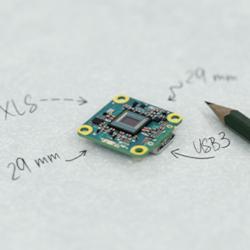The future of farming is driven by technology. In this article, Priva’s General Manager Middle East, Giovanni Angiolini, explores how the adoption of AgriTech can help achieve food security and self-sufficiency goals in 2022 and beyond.
 Creating a Climate for Growth
Creating a Climate for Growth

Giovanni Angiolini, General Manager Middle East | Priva
Food security and self-sufficiency are high up on the agenda of Governments across the Middle East, with many countries having established national food security strategies. Amongst other factors, population growth, urbanization, climate change, a fluctuating oil price, and most recently the global pandemic, are all factors that pose significant risks and challenges to sustainable food supply across the region. With only 1.7% of the total land area in the GCC countries being arable due to the region’s arid desert climate, up to 90% of the total demand for food is currently imported.
There have been significant strides in food security across the Middle East in recent years through government investment, public policy, knowledge partnerships and innovation in the agriculture sector. Although these all bode well for the future of the sector in the region, there is still a lot of work to do to transition to a sustainable farming model and achieve environmental and local production targets.
At Priva, our vision is to bring knowledge, people and technology together to contribute to a sustainable world where a growing population has access to safe and nutritious food. With this view, we opened our Middle East branch office in Dubai last year. Through our local presence on the ground, we work alongside local entrepreneurs, farmers, investors, educational institutes and the government, to help create a sustainable food ecosystem.
Achieving sustainable agriculture is a long-term challenge for the sector globally and firmly embedded in the ‘Zero Hunger’ goal as part of the UN Sustainable Development Goals (SDG). With 1.3 tonnes of food being wasted - of which 75 million tonnes* in the production of fruit and vegetables - whilst more than 2 billion people don’t have adequate access to food, we all understand the importance and urgency in getting this right. In addition, food waste is a key contributor to climate change accounting for 8% of global greenhouse gas emissions. Although food waste happens at every level in the supply chain, it’s important to note in this context that 20%** of the fruit and vegetable losses happen in the production phase.
Part of the way forward to address this, and work towards more sustainable growing and local food production, is the adoption of advanced technologies that allow growers to not only track their production yield and quality, but also their energy consumption and waste metrics.
Controlled-environment agriculture is particularly well-suited for harsh climates such as in the Middle East and we believe will play a fundamental role in feeding the cities of tomorrow and achieving the region’s self-sufficiency goals. Indoor farming allows for the year-round production of nutritious, pesticide-free food in urban areas with minimal transportation, water and waste.
The global Indoor Farming market is expected to reach a value of USD 24.9 billion by 2027 at a CAGR of 10.9% from 2020-2027***. In the MENA region, Vertical Farming grew from USD$ 0.38 billion in 2016 to USD$ 1.2 billion in 2021.
An important driver of the growth in this segment is the availability of advanced technology solutions. From integrated climate, process and irrigation controllers, autonomous growing and greenhouse automation solutions, to the use of Artificial Intelligence (AI) - like Plantonomy,™ Priva’s cloud-based service that uses smart algorithms that follow a plant’s biorhythm for predictive cultivation, and robotics - such as Priva’s Kompano, the world’s first automated leaf cutting robot for tomato crops, technology can transform agriculture and be instrumental in the achievement of food security strategies.
Here are three sample ways in which technology enables food for future:
1. Tracking water and energy usage to optimize crop yield and minimize food waste
With fresh water scarce in the GCC countries and the oil price fluctuating, the optimal use of water and energy is critical in boosting local sustainable food produce. By deploying climate and process controls in farms, water and energy usage can be effectively tracked and metrics put in place to ensure the data can be used to optimize crop yield and nutrition and reduce food wastage. Today, only 23.1% of respondents in the 2021 Global CEA Census Report use automated or semi- automated in-house tracking of sustainability metrics. 48% of respondents are tracking sustainability metrics by manually calculating every now and then, with another 27% of respondents not tracking at all. Hence there’s a significant gap to close.
2. Attracting and inspiring the next generation of growers
Globally, the average age of a farmer today is 60 years. To safeguard the future of farming we need to nurture the next generation of growers. In attracting young professionals, we need to rethink what it means to be a farmer. One way to do so is through technology and Priva is committed to promoting the sector as an attractive, high-tech career choice to a younger workforce of digital natives. We are talking to various universities and R&D centers in the Middle East to unite and collaborate on this, which is very exciting.
3. Collaboration and knowledge sharing are key to innovation
With the need for food production to increase by 60% by 2050 to sustain the world’s growing populationset to top 9 billion****, we need to find ways to further accelerate sustainable food production. To do so, we strongly believe at Priva that the key to achieving food security is collaboration and knowledge sharing. By exchanging data and best practices on the use of AgriTech, and by forging partnerships across sectors and borders to advance the adoption of technology, we will be able to transform to a sustainable farming model. Through the Priva Academy, we provide knowledge and training on a wide range of horticultural subjects to growers, their employees, crop advisers, and horticultural training institutes.
*Source: The Global CEA Census 2021
**Source: Washington Post (source dated February 21, 2021)
***Source: www.researchandmarkets.com
****Source: Food and Agriculture Organization of the United Nations (FAO)
The content & opinions in this article are the author’s and do not necessarily represent the views of AgriTechTomorrow
Comments (0)
This post does not have any comments. Be the first to leave a comment below.
Featured Product


